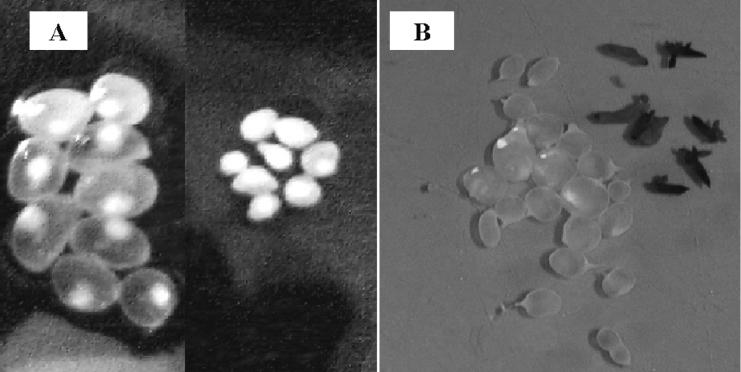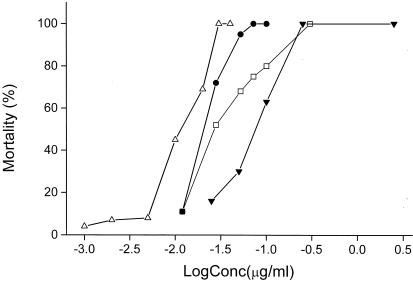Abstract
We investigated the minimum exposure times of prazicuantel (PZQ) and albendazole sulfoxide (ABZSO) required for their activities against Taenia cysts in vitro as well as the 50 and 99% effective concentrations. The results showed that although the effects of both drugs are time and concentration dependent, ABZSO acts much slower and is less potent than PZQ.
Several studies (3, 8) have evaluated the effects of praziquantel (PZQ) and albendazole sulfoxide (ABZSO) against different species of metacestodes, but this study is the first to evaluate the minimum exposure times required for activity and the effective concentrations of PZQ and ABZSO against Taenia solium and Taenia crassiceps cysts.
T. crassiceps cysts (ORF strain) were obtained from experimentally infected male BALB/c mice (age, 2 months). The mice were killed by cervical dislocation, and the metacestodes were removed from the peritoneal cavity. T. solium cysts were obtained from the skeletal muscle of naturally infected pigs. The parasites were washed with sterile 0.9% saline solution, and only those which exhibited an intact bladder surface were used for the experiments.
Stock solutions of ABZSO and PZQ were prepared in dimethyl sulfoxide (DMSO) and ethanol, respectively. Working solutions of the drugs were prepared with culture medium to obtain PZQ concentrations from 0.001 to 0.3 μg/ml and ABZSO concentrations from 0.0125 to 2.5 μg/ml. Culture media containing 0.25% DMSO or 0.05% ethanol were prepared as controls. Each cell culture flask contained 25 cysts in 5 ml of culture medium and was incubated at 37°C with 5% CO2. The parasites were observed with an inverted light microscope (Reichert 569). The criteria used to assess cyst mortality in vitro were total paralysis of the membrane and cyst collapse. In order to determine the exposure time required for activity for PZQ, the cysts were observed each 15 min for 6 h; after this time, observations were made each 24 h for 11 days. For ABZSO, the parasites were observed each 24 h for 11 days. The culture medium was changed every day. Each experiment was performed in quadruplicate.
The effective concentrations that killed 50 and 99% of the parasites (EC50s and EC99s, respectively) were determined at 4 and 6 h and 11 days for PZQ and at 11 days for ABZSO. Each experiment was performed in triplicate. Data were analyzed by logistic regression by using SPSS software (version 9.0).
When the cysts were exposed to the drugs, an immediate contraction of the membrane was found; extensive vacuolization of the teguments and evagination were also observed.
Figure 1A shows the loss of the cystic fluid of T. solium cysts after treatment with PZQ, and Fig. 1B shows the loss of the integrity of the membrane when the T. crassiceps cysts were exposed to the drugs.
FIG. 1.
(A) T. solium cysts: control cysts (left) and dead cysts after treatment with PZQ (right). Note the loss of cystic fluid and that only the scolex is visible after the drug treatment. (B) T. crassiceps cysts: control live cysts (left) and cysts after treatment with the drugs (right). Note the size reduction and the loss of cystic fluid in the parasites.
The maximum effects on T. crassiceps and T. solium cysts were observed after 4 and 6 h, respectively, when the concentrations of PZQ were in the range of 0.012 to 0.1 μg/ml. When the effects of PZQ against T. crassiceps cysts were evaluated at lower concentrations (0.001 to 0.04 μg/ml), we found that the maximum effect was obtained after 9 days of exposure. These results show that the effects of PZQ on T. solium and T. crassiceps cysts are time and concentration dependent. These results are in accordance with those presented in previous reports of studies with other metacestodes (2, 3, 4, 8).
Data on the mortality of T. solium cysts were plotted against data on the mortality of T. crasssiceps cysts after PZQ treatment. A linear relationship with a slope of 1.36 was found. These results indicate that T. crassiceps could be used as a reliable model to evaluate the in vitro effects of cestocidal drugs.
When the effect of ABZSO against T. solium cysts was evaluated, we found that after 5 days of incubation, 50% of the cysts evaginated and transformed to young Taenia, which survived for only 24 h. These changes were also observed in control cultures; therefore, we could perform the study only with the T. crassiceps model. With this model the effect of ABZSO was slower than that of PZQ, and the maximum effect was attained at 11 days of exposure. The lag time in the effect could be due to the mechanism of action of ABZSO, since the efficacies of benzimidazole carbamates have been demonstrated to be slow (5, 8).
The results of the present study show that the effect of ABZSO, like that of PZQ, is time and concentration dependent; however, longer incubation periods in vitro are required with ABZSO to attain the maximum effect. Our observations agree with those found for other metacestodes species (1, 6, 7).
In order to calculate the EC50s and EC99s of PZQ and ABZSO, the maximal rate of mortality of Taenia cysts was plotted against different concentrations of each drug (Fig. 2). The results are given in Table 1. We found that the EC50s of PZQ for T. crassiceps decreased from 0.023 to 0.011 μg/ml when the exposure time was increased from 4 h to 11 days. The EC50 of PZQ was slightly higher for T. solium cysts (0.034 μg/ml).
FIG. 2.
In vitro efficacies of PZQ and ABZSO. Each point represents the mean ± standard deviation percentage of dead cysts from three different experiments. □, PZQ against T. solium cysts at 6 h; •, PZQ against T. crassiceps cysts at 4 h; ▵, PZQ against T. crassiceps cysts at 11 days; ▾, ABZSO against T. crassiceps at 11 days.
TABLE 1.
In vitro effective concentrations of PZQ and ABZSO against T. crassiceps and T. solium cysts
| Species | Drug (time of determination) | EC50 (μg/ml) | EC99 (μg/ml) |
|---|---|---|---|
| T. solium | PZQ (6 h) | 0.034 (0.023-0.045)a | 0.537 (0.25-2.98) |
| T. crassiceps | PZQ (4 h) | 0.023 (0.021-0.025) | 0.113 (0.09-0.15) |
| PZQ (11 days) | 0.011 (0.005-0.022) | 0.105 (0.04-19.09) | |
| ALBSO (11 days) | 0.068 (0.041-0.0112) | 0.556 (0.23-17.32) |
Values in parentheses are 95% confidence intervals.
The mean EC99s of PZQ for T. crassiceps cysts at 4 h and 11 days were similar (0.113 and 0.105 μg/ml, respectively), which indicates that at concentrations higher than 0.1 μg/ml the effect of PZQ could be independent of the incubation time. The mean EC99 of PZQ for T. solium cysts was 0.537 μg/ml, which is five times higher than that obtained for T. crassiceps cysts (0.113 μg/ml). The EC50s and EC99s of ABZSO for T. crassiceps cysts at 11 days of exposure were 0.068 and 0.556 μg/ml, respectively, showing that PZQ is more potent than ABZSO.
The results of the present study indicate that the time of exposure and the effective concentrations are important for destruction of the parasite and could provide the basis for the establishment of an effective therapy for the treatment of neurocysticercosis. Also, in vivo studies are required in order to relate our in vitro data to the concentrations of the drugs effective clinically.
Acknowledgments
We thank Alma Rosa Cortés for statistical assistance.
REFERENCES
- 1.Casado, N., G. Pérez-Serrano, G. Denegri, and F. Rodríguez-Caabeiro. 1996. Development of a chemotherapic model for the in vitro screening of drugs against Echinococcus granulosus cysts: the effects of an albendazole-albendazole sulphoxide combination. Int. J. Parasitol. 26:59-65. [DOI] [PubMed] [Google Scholar]
- 2.Chinnery, J. B., and D. L. Morris. 1986. Effect of albendazole sulphoxide on viability of hydatid protoscoleces in vitro. Trans. R. Soc. Trop. Med. Hyg. 80:815-817. [DOI] [PubMed] [Google Scholar]
- 3.Da Silva, S. P., and F. Noel. 1995. Time course of the effect of praziquantel on Schistosoma masoni attachment in vitro: comparison with its effects on worm length and motility. Parasitol. Res. 81:543-548. [DOI] [PubMed] [Google Scholar]
- 4.Ingold, K., P. Bigler, T. Wolfgang, T. Cavaliero, B. Gottstein, and A. Hemphill. 1999. Efficacies of albendazole sulfoxide and albendazole sulfone against in vitro-cultivated Echinococcus multilocularis metacestodes. Antimicrob. Agents Chemother. 43:1052-1061. [DOI] [PMC free article] [PubMed] [Google Scholar]
- 5.Lancey, E. 1990. Mode of action of benzimidazoles. Parasitol. Today 6:112-115. [DOI] [PubMed] [Google Scholar]
- 6.Pérez-Serrano, J., N. Casado, and G. Denegri. 1994. The effects of albendazole and albendazole sulphoxide combination-therapy on Echinococcus granulosus in vitro. Int. J. Parasitol. 24:219-224. [DOI] [PubMed] [Google Scholar]
- 7.Taylor, D., and D. Morris. 1988. In vitro culture of Echinococcus multilocularis: protoscolicidal action of praziquantel and albendazole sulphoxide. Trans. R. Soc. Trop. Med. Hyg. 82:265-267. [DOI] [PubMed] [Google Scholar]
- 8.Urrea-París, M., M. Moreno, N. Casado, and F. Rodríguez-Caabeiro. 2000. In vitro effect of praziquantel and albendazole combination therapy on the larval stage of Echinococcus granulosus. Parasitol. Res. 86:957-964. [DOI] [PubMed] [Google Scholar]




